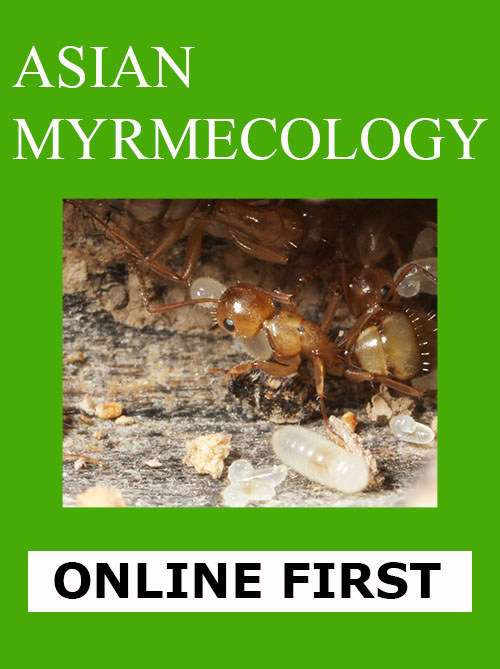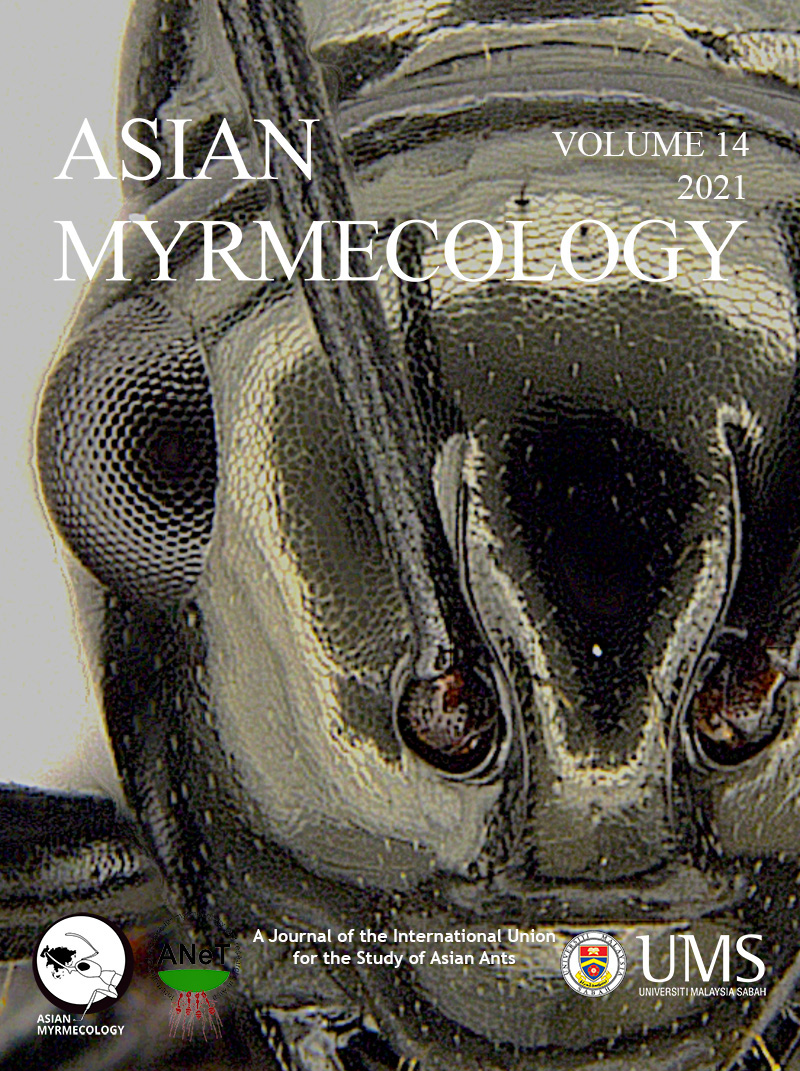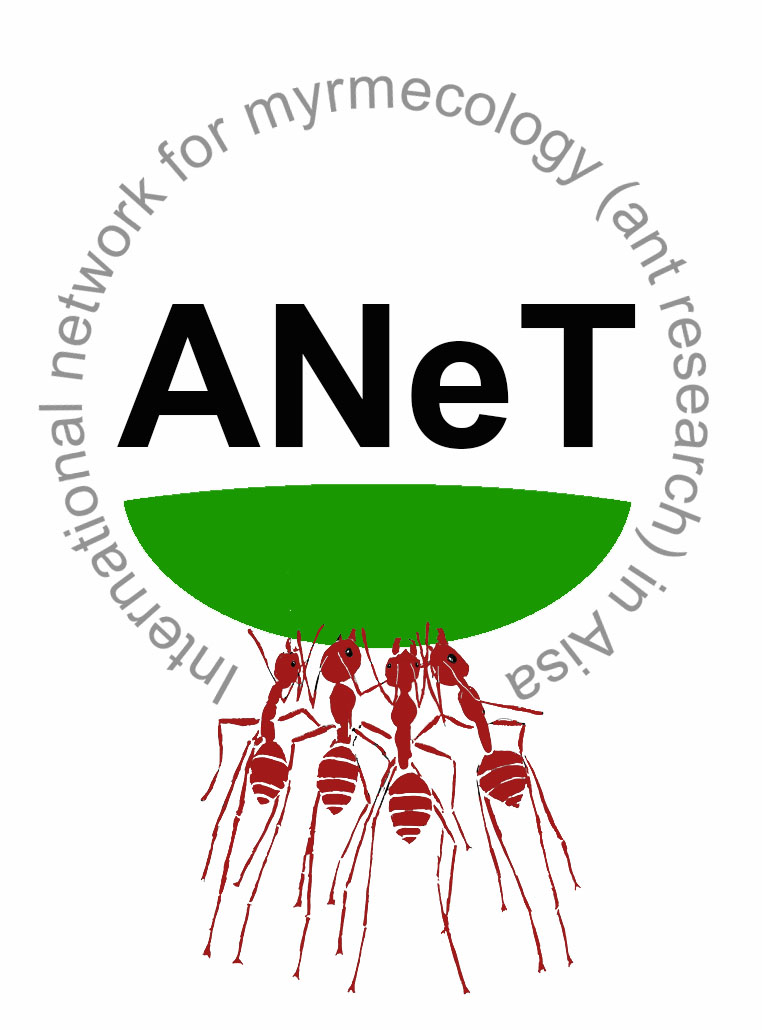ASIAN
MYRMECOLOGY
Image: François Brassard
DOI: 10.20362/am.015001
Asian Myrmecology 15: 015001 (1-10)
article first published online: 7/February/2022
Trophic eggs in three ponerine ant species: Harpegnathos venator, Odontomachus simillimus and Odontoponera denticulata
SUNITTRA AUPANUN1,2, MITSUHIRO OBIKA2, RIOU MIZUNO2, WEEYAWAT JAITRONG3, PIYAWAN SUTTIPRAPAN1, ROSLI HASHIM4 & FUMINORI ITO2*
Abstract:
Trophic eggs in ants have been well known for a long time, however, published information of trophic eggs in poneroid ants is relatively scarce. We observed the production and fate oftrophic eggs in relation to female castes and reproductive status in three species of ponerine ants in SE Asia. In all species, trophic eggs were principally offered to and eaten by reproductive females.When the trophic eggs were refused by reproductive females, other colony members fed on the trophic eggs. Reproductive females of the three species fed on both insect prey and trophic eggs, however, theproportion of time spent eating the two types of prey varied among species and also among colonies.In Harpegnathos venator, trophic eggs were laid by non-reproductive females including virgin workers, virgin queens, and mated but infertile workers. All trophic eggs were eaten by mated queens orgamergates (mated and egg-laying workers). The rate of trophic egg laying was as low as 0.0187 ± SD0.0110 per individual per hour (i.e. on average one egg every two days 5 hours 29 min.). In Odontoponera denticulata, workers laid on average 0.0115 ± 0.009 trophic eggs per worker per hour (i.e. one egg every three days 14 hours 57 min.). All egg laying workers first brought trophic eggs to queens, but queens fed on only ca. 20% of the trophic eggs. Furthermore, queens rarely showed complete feeding. In most cases, queens ate the eggs halfway through and dumped the rest. These dumped eggs were picked up by workers, and given to larvae or eaten by workers. In Odontomachus simillimus, queen feeding behavior varied from insect prey to trophic eggs depending on colony growth stage. When the colony was large, workers laid trophic eggs at a low rate of 0.0035/individual/hour (i.e. one egg every 11 days 21 hours 43 min.) and most trophic eggs laid by workers were eaten by the queen.
Keywords:
Feeding habit, Harpegnathos, Odontomachus, Odontoponera, Ponerinae, Trophic egg
Get PDF (0.4 MB) :
SUNITTRA AUPANUN1,2, MITSUHIRO OBIKA2, RIOU MIZUNO2, WEEYAWAT JAITRONG3, PIYAWAN SUTTIPRAPAN1, ROSLI HASHIM4 & FUMINORI ITO2*
Abstract:
Trophic eggs in ants have been well known for a long time, however, published information of trophic eggs in poneroid ants is relatively scarce. We observed the production and fate oftrophic eggs in relation to female castes and reproductive status in three species of ponerine ants in SE Asia. In all species, trophic eggs were principally offered to and eaten by reproductive females.When the trophic eggs were refused by reproductive females, other colony members fed on the trophic eggs. Reproductive females of the three species fed on both insect prey and trophic eggs, however, theproportion of time spent eating the two types of prey varied among species and also among colonies.In Harpegnathos venator, trophic eggs were laid by non-reproductive females including virgin workers, virgin queens, and mated but infertile workers. All trophic eggs were eaten by mated queens orgamergates (mated and egg-laying workers). The rate of trophic egg laying was as low as 0.0187 ± SD0.0110 per individual per hour (i.e. on average one egg every two days 5 hours 29 min.). In Odontoponera denticulata, workers laid on average 0.0115 ± 0.009 trophic eggs per worker per hour (i.e. one egg every three days 14 hours 57 min.). All egg laying workers first brought trophic eggs to queens, but queens fed on only ca. 20% of the trophic eggs. Furthermore, queens rarely showed complete feeding. In most cases, queens ate the eggs halfway through and dumped the rest. These dumped eggs were picked up by workers, and given to larvae or eaten by workers. In Odontomachus simillimus, queen feeding behavior varied from insect prey to trophic eggs depending on colony growth stage. When the colony was large, workers laid trophic eggs at a low rate of 0.0035/individual/hour (i.e. one egg every 11 days 21 hours 43 min.) and most trophic eggs laid by workers were eaten by the queen.
Keywords:
Feeding habit, Harpegnathos, Odontomachus, Odontoponera, Ponerinae, Trophic egg
Get PDF (0.4 MB) :
1Department of Entomology and Plant Pathology, Faculty of Agriculture, Chiang Mai University, Chiang Mai 50200, Thailand
2Faculty of Agriculture, Kagawa University, Ikenobe, Miki, Kagawa 761-0795, Japan
3Thailand Natural History Museum, National Science Museum, Technopolis, Khlong 5, Khlong Luang, Pathum Thani 12120, Thailand
4Institute of Biological Science, Faculty of Science, University of Malaya, 50603 Kuala Lumpur, Malaysia
*Corresponding author: ito.fuminori@kagawa-u.ac.jp



